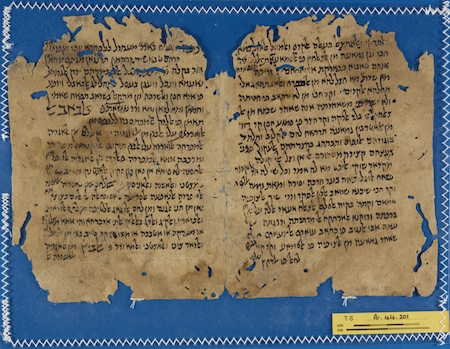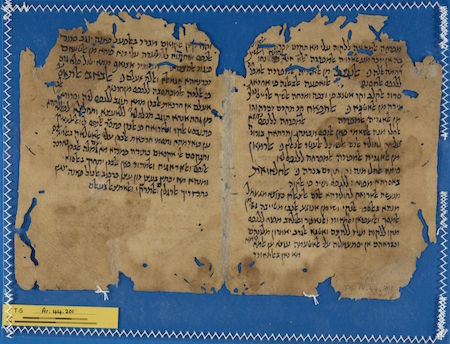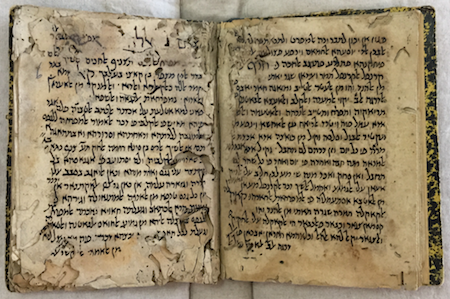The Pursuit of Happiness: T-S Ar.44.201
by Alan Elbaum
This Genizah fragment relates “on unimpeachable authority” an event that took place at a lively Sufi meditation ceremony in the early 1200s in present-day Syria in the city of Raqqa. A group of holy men had gathered together with musicians, and they soon attained the utmost level of delight in their hearts, souls, and intellects. One of them broke into song, and, when he reached the line, “My desire for you is infinite, though all things are finite,” he made a small movement, let out a scream, and died (“may God have mercy upon him”). There follows a similar story, attributed to the Sufi master Shihāb al-Dīn al-Suhrawardī, which he heard from his uncle Abū Najīb, but the text of the story—like the life of the unfortunate protagonist—is cut off.
The fragment is a bifolium, and these stories appear on the last page out of the four. On the first page, we have a medical recipe incorporating ingredients such as saffron, honey, and Levantine apples, as well as South Asian ingredients such as ihlīlaj kābulī (chebulic myrobalan) and ṭabāshīr (a bamboo derivative). We learn about the pharmacodynamics of Levantine apples on the second page: “Apples are among the simple [as opposed to compound] foods that bring delight to the soul—especially the Levantine variety—for the soul rejoices and reposes with their ingestion due to the formation of fragrant, pure blood.” In fact, this bifolium, written in scribal Judaeo-Arabic (i.e., Arabic in Hebrew characters), replete with Sufi stories and psychoactive pharmaceutics, belongs to a very peculiar medical textbook.
T-S Ar.44.201 recto
T-S Ar.44.201 verso
We owe thanks to Paul Fenton for identifying the source in 1981: Mufarriḥ al-Nafs (The Soul-Cheerer) by Badr al-Dīn Muẓaffar, the son of the judge of Baʿalbek, who served under the Ayyūbids as the Chief Medical Officer of Damascus in the mid-13th century. Fenton observed that this fragment belongs together with a set of 20 additional folios, which are bound together in a volume in the Cambridge University Library Oriental collection (CUL Or.1035.1). The scribe is the same, and the Genizah bifolium corresponds to one of the book’s missing sections. The pages in the book are larger both widthwise and lengthwise than the Genizah fragment, which must have been separated from the book at some stage prior to its most recent trimming and re-binding. (That the book has gone through at least two bindings is evident from the wormholes, which are discontinuous wherever the pages have been shuffled from their original order.) The book was acquired from Solomon Aaron Wertheimer of Jerusalem in 1896; in all likelihood, it too came from the Genizah.
CUL Or.1035.1
Though much of the book is missing, the first folio has been mercifully preserved, so we have the author’s name, his statement of his purpose, and the full table of contents. In the very brief introduction, Badr al-Dīn explains that, when he surveyed the existing medical literature, he found a dearth of information about those things which cure “the ailments of the heart” by bringing joy, repose, happiness and delight. He notes that Avicenna did indeed write a treatise on cardiac drugs (al-ʾAdwiya al-Qalbiyyah), but this work characterizes only one type of soul-cheerer (viz., drugs) in great depth while neglecting the others. Badr al-Dīn’s book, by contrast, describes every type: there is one chapter on each of the physical senses, one chapter on drugs that cheer, one chapter on foods that cheer, one chapter on movements of the body (wherein the story of the Raqqan crooner), and a final chapter on the inner senses (which mediate the satisfaction that comes with such activities as science, poetry, and hunting). Badr al-Dīn charmingly draws on his knowledge of the soul to justify his book’s brevity: “I aimed for concision in every chapter to encourage continual study, for the soul hates long-windedness.”
Badr al-Dīn lived just in the nick of time to be included in Ibn Abī Uṣaybiʿah’s encyclopedia of medical biographies (ʿUyūn al-anbāʾ fī ṭabaqāt al-aṭibbāʾ), which covers 442 physicians over two millennia, from Apollo and Asclepius to Yazīd ibn Zayd. Indeed, Ibn Abī Uṣaybiʿah and Badr al-Dīn—both practicing physicians belonging to the medical elite of mid-13th-century Syria—were personally acquainted. Even better, Ibn Abī Uṣaybiʿah devotes substantial space to an adulatory review of the very same book represented by our Genizah fragment. When The Soul-Cheerer first fell into his hands, he wrote the following piece of fan mail:
‘In this book you surpassed former scholars, preceded all other physicians and philosophers, liberated anguished hearts and became the unquestionable leader in your lofty rank, with nobody to vie for your perfection and mastership….’
In the same epistle I included the following verses, addressed to him extemporaneously:
‘The rising sun was almost eclipsed by the radiance of Badr al-Dīn….
Indeed he presented my heart with his book The Soul-Cheerer,
A book which leads us into the world of holiness,
The light of its import shines in the darkness of my soul.
How beautiful is the flower of the handwriting in the paper-garden!
When the eye falls upon its first thoughts, it is refreshed;
How much comfort and delight I have received from it!
I have accepted its contents with kisses and learning,
And shall gather its fruit, sweeter than that of the sweetest fruit tree.’
Perhaps the poem overstates the point, but it is clear that The Soul-Cheerer was a unique medical text in its time. It takes a special intuition to try to create a single category out of disparate stimuli such as apples, Sufi dancing, poetry, and chebulic myrobalan, to posit that the soul-cheering effects of each are mediated by comparable physiological mechanisms—some 700 years before the discovery of dopamine reward pathways—and, finally, to resolve that what the world needs most is a textbook setting forth the secrets of synthesizing happiness. No wonder that there was a demand for this text among the Jews of Old Cairo.
Sources
Readers of German can find much more information on Badr al-Dīn and on the extant manuscripts of this work in J. C. Bürgel’s article “Der Mufarriḥ an-Nafs.” For a shorter synopsis in English focusing on its musical aspects, see Bürgel’s article, “Musicotherapy in the Islamic Middle Ages.” There is also a modern Arabic edition of Mufarriḥ al-Nafs accompanied by several essays, edited by Dr. ‘Abdul-Fattaḥ Ḥannūn and Dr. Yāsir Ṣabbāgh and published by Dar Al-Kotob Al-Ilmiyah in Beirut in 2006. The text of the printed edition is based on two manuscripts, one from the al-Ẓāhiriyyah Library in Damascus and one from the Institute of Arabic Manuscripts in Cairo. A final note: in May of 1975, Samira Jadon delivered a paper at the Ninth Annual Medieval Conference at the State University of New York at Binghamton entitled “Islamic Medicine: The Mss. of Mufarrih al-nafs, Its Author and Its Impact.” This paper was never published and seems to have been lost in the mists of time, but if any readers know otherwise—or whether the author herself can be contacted—please send an email to alanelbaum@gmail.com.
Bürgel, Johann Christoph. “Der Mufarriḥ an-Nafs Des Ibn Qāḍī Baʿalbakk, Ein Lehrbuch Der Psychohygiene Aus Dem 7. Jahrhundert Der Hiğra.” N.p., 1972. 201–212. Print.
---. “Musicotherapy in the Islamic Middle Ages as reflected in medical and other sources.” Studies in History of Medicine 4 (1980): 23–28. Print.
Fenton, Paul. “Review of Medical and Para-Medical Manuscripts in the Cambridge Genizah Collections by Haskell D. Isaacs.” Revue des Etudes Juives 156 (1997): 392–395. Print.
Ibn Abī Uṣaybiʿah. History of Physicians. Trans. L. Kopf. National Library of Medicine, 1971. http://www.tertullian.org/fathers/ibn_abi_usaibia_03.htm. Accessed August 3, 2016.
Acknowledgments
My time at the Genizah Research Unit at the Cambridge University Library has been generously funded by the UC Berkeley-UCSF Joint Medical Program, the UC Berkeley Center for Jewish Studies, and the UC Berkeley Center for Middle Eastern Studies.
Cite this article
(2016). The Pursuit of Happiness: T-S Ar.44.201. [Genizah Research Unit, Fragment of the Month, September 2016]. https://doi.org/10.17863/CAM.8159
If you enjoyed this Fragment of the Month, you can find others here.
Contact us: genizah@lib.cam.ac.uk
The zoomable images are produced using Cloud Zoom, a jQueryimage zoom plugin:
Cloud Zoom, Copyright (c) 2010, R Cecco, www.professorcloud.com
Licensed under the MIT License



